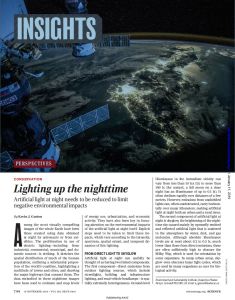Join getAbstract to access the summary!

Join getAbstract to access the summary!
Kevin J. Gaston
Lighting Up the Nighttime
Artificial light at night needs to be reduced to limit negative environmental impacts.
Science, 2018
What's inside?
Light pollution threatens humans and other organisms – but there are ways to minimize the harm.
Recommendation
Humanity’s growing use of light at night brings both threat and opportunity, says biologist Kevin Gaston. Indiscriminate use of light at night can disrupt human sleep cycles, animal migration and breeding. It can also cause alterations in plant growth cycles that lead to cascading disruptions to ecosystems. But much of the potential harm can be allayed by strategically using lighting in a way that meets people’s needs while minimizing harm. This article will engage architects, engineers, planners and anyone involved in decisions about installing and managing artificial lighting.
Summary
About the Author
Kevin J. Gaston is a professor of biodiversity and conservation with the Environment and Sustainability Institute at the University of Exeter, UK.

















Comment on this summary